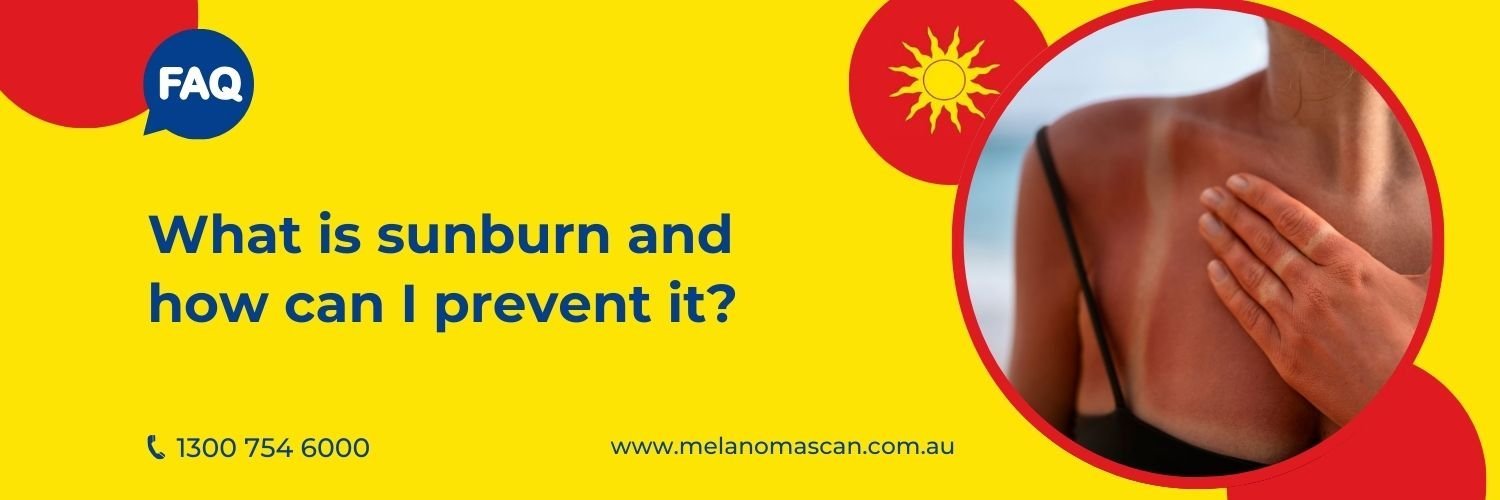Sunburn is the reaction of your skin to exposure to ultraviolet radiation from the sun. Depending on your skin type and the season, sunburn can occur after as little as ten minutes of sun exposure if adequate protection is not provided. Fair skin types and people with light-coloured hair and eyes are the most prone to sunburn and hence to the subsequent development of skin cancer. Most Australians are aware of the danger of sun exposure, but sunburn is still very common because people underestimate the amount of ultraviolet radiation they are exposing themselves to. This includes days when it is overcast, cooler or windy, when the burning effects of the sun may not be noticed before a sunburn has already happened. All sunburns cause damage to the cells of your skin, and these changes include damage to the DNA of your cells. Over many years, enough damage to the DNA of your cells can accumulate to cause skin cancer to develop. Many older people experience skin cancers many years after the activities that caused them have stopped and may continue to have skin cancers appear from time to time despite minimal sun exposure.
Prevent Sunburn and Skin Cancer with These SunSmart Tips
Sunburn and skin cancer are serious concerns related to sun exposure, especially during the hot summer months. Understanding the symptoms and risks associated with sunburn is crucial for maintaining skin health. By following SunSmart practices and utilising proper sun protection measures, you can significantly reduce the risk of sunburn and skin cancer.
Sunburn Symptoms and Prevention
Recognising the Symptoms of Sunburn
Sunburn is characterised by red, inflamed skin that may feel hot to the touch. It can also cause pain, itching, and tenderness. Severe sunburn may lead to blistering and peeling of the skin, indicating significant damage to the skin cells.
How Can Sunburn Be Prevented?
To prevent sunburn, it is essential to limit sun exposure during peak hours when UV radiation is strongest. Using sunscreen with a high Sun Protection Factor (SPF) and wearing protective clothing, such as hats and sunglasses, can provide additional protection against harmful UV rays.
Effective Sunburn Treatments
If you do get sunburned, it is important to treat your skin gently. Applying cool compresses, moisturizing lotions, and staying hydrated can help soothe the discomfort. Avoiding further sun exposure until the skin heals is crucial to prevent additional damage.
Sunscreen and Sun Protection
Understanding UV Rays and Their Impact
UV rays are a type of radiation from the sun that can penetrate the skin and cause damage. Prolonged exposure to UV rays increases the risk of skin cancer and accelerates skin aging. Understanding the different types of UV rays and their impact on the skin is essential for sun protection.
The Importance of Using Sunscreen
Sunscreen is a vital tool in protecting the skin from harmful UV exposure. It acts as a barrier that absorbs or reflects UV rays, preventing them from penetrating the skin. Regular application of broad-spectrum sunscreen with a high SPF can significantly reduce the risk of sunburn and skin cancer.
Choosing the Right Sun Protection
When selecting sunscreen, look for products with a high Sun Protection Factor (SPF) and broad-spectrum protection that shields against both UVA and UVB rays. Additionally, wearing protective clothing, such as long sleeves and pants, along with sunglasses, further enhances sun protection.
SunSmart and Sun Safety Practices
Reducing the Risk of Sunburn and Skin Cancer
Adopting SunSmart practices is key to minimising the risk of sunburn and skin cancer. This includes seeking shade during peak sun hours, wearing sunscreen, and using protective clothing to shield the skin from harmful UV exposure. Regular skin checks and screenings also help in the early detection of skin issues.
Protecting Your Skin from Harmful UV Exposure
Avoiding excessive sun exposure, especially between 10 a.m. and 4 p.m. when UV rays are strongest, is essential for skin protection. Applying sunscreen generously and reapplying every two hours, or after swimming or sweating, ensures continuous UV protection throughout the day.
Utilising SunSmart Strategies for Sun Protection
Utilising SunSmart strategies, such as wearing UV-protective clothing, wide-brimmed hats, and sunglasses, enhances sun protection. The Cancer Council recommends staying SunSmart by following simple yet effective practices that safeguard your skin from UV damage and reduce the risk of skin cancer.


 Prevention Tips
Prevention Tips Early Detection
Early Detection Understanding Skin Cancer
Understanding Skin Cancer Success Stories
Success Stories Lifestyle and Skin Health
Lifestyle and Skin Health Advances in Treatment
Advances in Treatment Community & Events
Community & Events For Families
For Families What's Happening at Melanoma Scan?
What's Happening at Melanoma Scan?